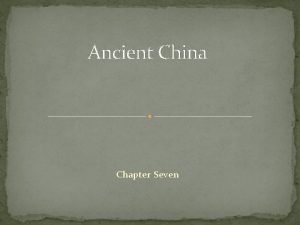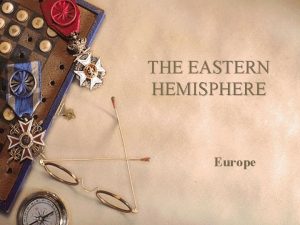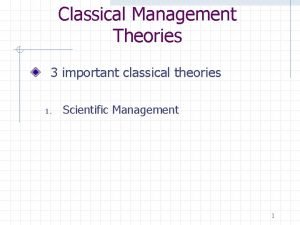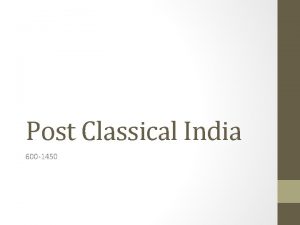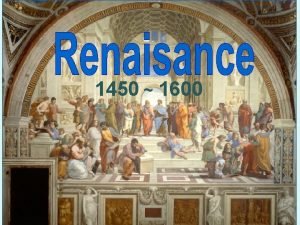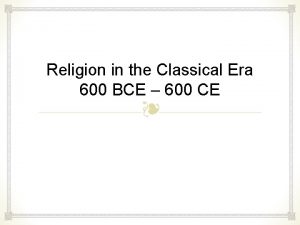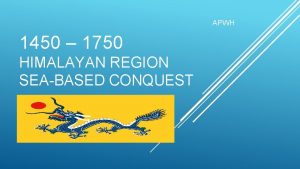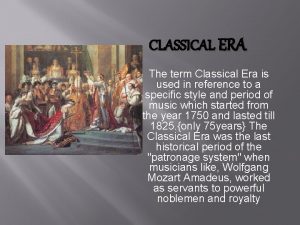600 CE 1450 CE Post Classical Era Himalayan












- Slides: 12

600 CE – 1450 CE Post Classical Era Himalayan Region Land-Based Empires Founding of Islam

• Improved transportation technologies and commercial practices led to an increased volume of trade, and expanded the geographical range of existing and newly active trade networks. • The growth of inter-regional trade in luxury goods (silk and cotton textiles, porcelain, spices, precious metals and gems, slaves, exotic animals) • Trade was encouraged by significant innovations in previously existing transportation and commercial technologies, including more sophisticated caravan organization (Caravanserai, Camel saddles). 600 CE – 1450 CE

Larger ship designed in sea travel and new forms of credit and monetization (Bills of exchange, Credit, Checks, Banking houses) were used. Commercial growth was also facilitated by state practices (Minting of coins, use of paper money). State-sponsored commercial infrastructures like the Grand Canal in China. The expansion of EMPIRES facilitated Trans-Eurasian trade and communication as new peoples were drawn into their conquerors’ economies and trade networks. 600 CE – 1450 CE

600 CE – 1450 CE

The movement of peoples caused environmental and linguistic effects. The expansion and intensification of long-distance trade routes often depended on environmental knowledge and technological adaptations to it. Some migrations had a significant environmental impact. The maritime migrations of the Polynesian peoples who cultivated transplanted foods and domesticated animals as they moved to new islands. Cross-cultural exchanges were fostered by the intensification of existing, or the creation of new, networks of trade and communication. 600 CE – 1450 CE

600 CE – 1450 CE

Some migrations and commercial contacts led to the diffusion of languages (spread of Bantu languages including Swahili, Spread of Turkic and Arabic languages)throughout a new region or the emergence of new languages. Islam, based on the revelations of the prophet Muhammad, developed in the Arabian peninsula. The beliefs and practices of Islam reflected interactions among Jews, Christians, and Zoroastrians with the local Arabian peoples. Muslim rule expanded to many parts of Afro-Eurasia due to military expansion, and Islam subsequently expanded through the activities of merchants and missionaries. 600 CE – 1450 CE

In key places along important trade routes, merchants set up diasporic communities (Muslim merchant communities in the Indian Ocean region, Chinese merchant communities in Southeast Asia, Sogdian merchant communities throughout Central Asia, Jewish communities in the Mediterranean, Indian Ocean Basin, or along the silk roads)where they introduced their own cultural traditions into the indigenous culture. The writings of certain interregional travelers (Ibn Battuta, Marco Polo, Xuanzang)illustrate both the extent and the limitations of intercultural knowledge and understanding. 600 CE – 1450 CE

Increased cross-cultural interactions resulted in the diffusion of literary, artistic, and cultural traditions (Neoconfucianism and Buddhism in Southeast Asia, Hinduismand Buddhism in Southeast Asia, Islam in Sub-saharan Africa and Southeast Asia, Toltec/Mexica and Inca traditions in Mesoamerica and Andean America). Increased cross-cultural interactions also resulted in the diffusion of scientific and technological traditions (Greek and Indian mathematics on Muslim scholars, return of Greek science and philosophy to Western Europe via Muslim al-Andalus in Iberia, Spread of printing and gunpowder technologies from East Asia into the Islamic empires and Western Europe). 600 CE – 1450 CE

There was continued diffusion of crops and pathogens throughout the Eastern Hemisphere along the trade routes. New foods and agricultural techniques (Bananas in Africa, New rice varieties in East Asia, Spread of Cotton, sugar, and citrus throughout Dar-al-Islam and the Mediterranean basin)were adopted in populated areas. The spread of epidemic diseases, including the Black Death, followed the well established paths of trade and military conquest. Empires collapsed and were reconstituted; in some regions new state forms emerged (2011 COMPARE-CONTRAST ESSAY TOPIC) (2014 COMPARE CONTRAST ESSAY). 600 CE – 1450 CE

600 CE – 1450 CE

600 CE – 1450 CE
 1450*3
1450*3 Post classical era timeline
Post classical era timeline What is forked line method
What is forked line method Himalayan graduate school of theology
Himalayan graduate school of theology Guest lecturer in geography
Guest lecturer in geography Himalayan mountains ancient china
Himalayan mountains ancient china Himalayan bank merger
Himalayan bank merger Aromatic himalayan plant
Aromatic himalayan plant Europe in which hemisphere
Europe in which hemisphere Sudut istimewa
Sudut istimewa Classical era opera
Classical era opera Classical management era
Classical management era Classical music era timeline
Classical music era timeline





